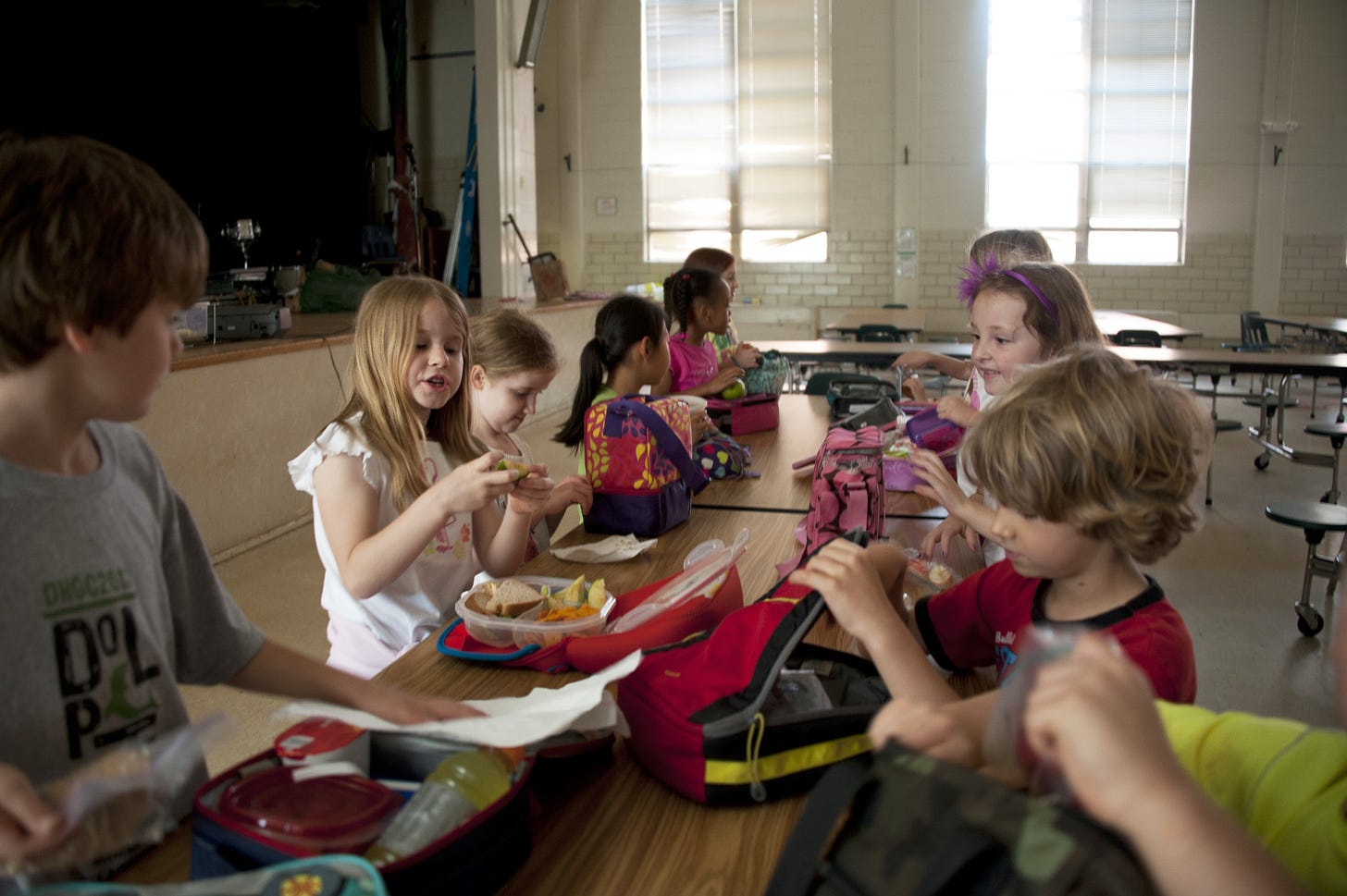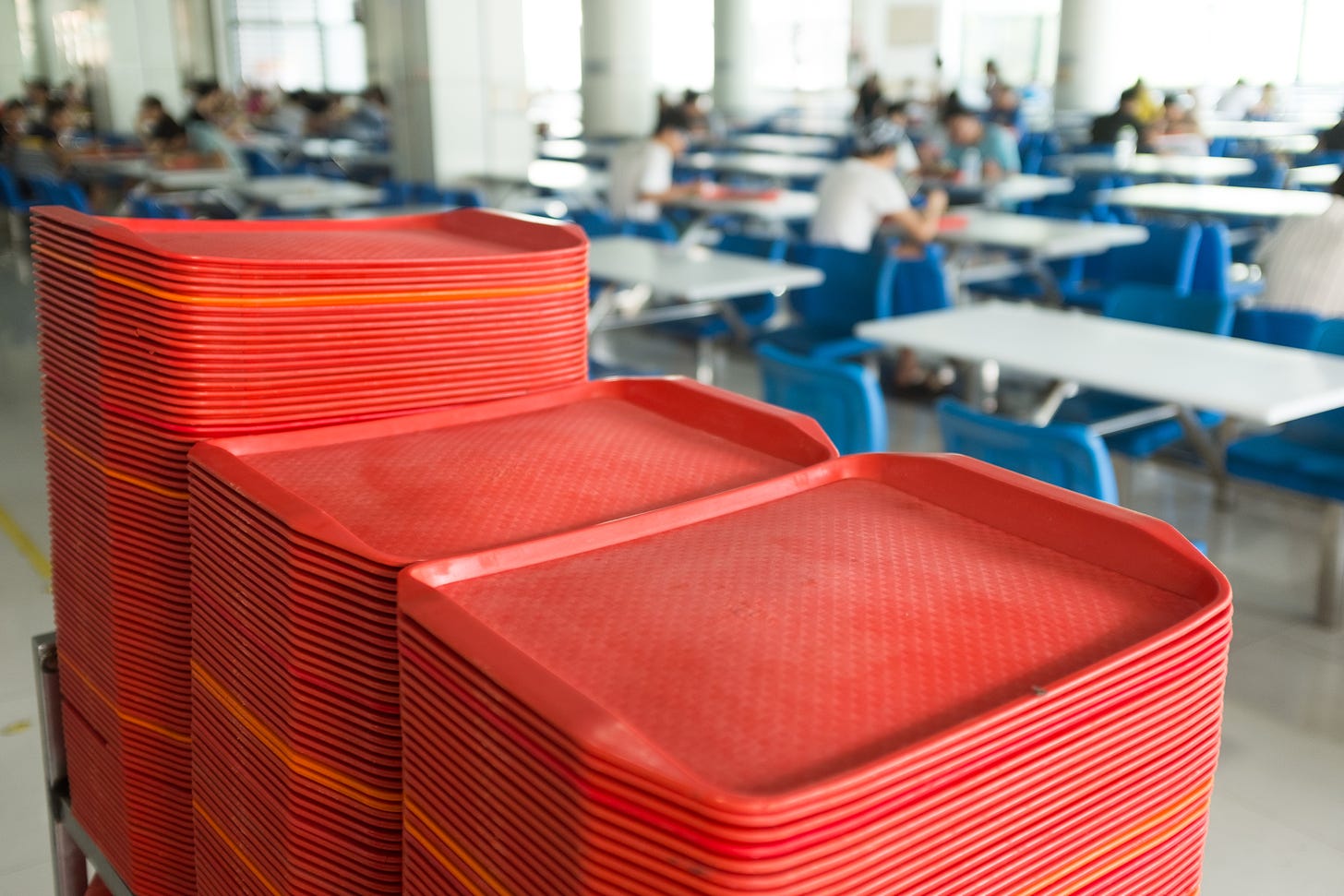Please Stop Romanticizing Your Child’s Lunchbox
Universal free school lunch could save us all, but diet culture is getting in the way.
Coming Up! In Thursday’s subscriber-only audio newsletter, I’ll be speaking with Gwen Kostal, a registered dietitian in Canada and founder of Dietitians 4 Teachers, about how diet culture shows up in school classrooms and cafeterias. We’re answering a TON of your questions (culled from my Instagram and our recent Friday school lunch thread). If your kid ever reports a weird thing their teacher said about food or bodies, this is going to be the episode you need. (Teachers, I think you’ll find it helpful too!)
But first, there’s another conversation we need to have about schools, lunch, and the diet culture messaging that parents put on the table.
Back in April, the USDA announced that it would extend a waiver that allows schools to serve free meals to all students through the entire 2021-2022 school year. Families no longer have to apply or demonstrate eligibility for free lunches in most districts; cafeterias are just feeding every kid who shows up for lunch. This effort started as a response to the pandemic-fueled increase in childhood hunger, as I reported for the New York Times last year. And anti-hunger advocates are hoping to make it a permanent change by getting Congress to pass the Universal School Meals Act. So we are now officially back to school in every district in the nation, and most kids are walking into a radically different cafeteria than ever before.
There are some nuances to this, of course. “Please note that USDA is not providing a free universal meal program,” a USDA spokesperson told me via email because I guess the government never wants to look like it’s caring too much. States have to opt in to the waiver before schools can serve free meals to all; otherwise they can participate in the normal National School Lunch Program, where kids pay full price, reduced price, or nothing based on their family’s income eligibility (meaning schools and families still have to do that application process).
And some, such as the Waukesha School District in Wisconsin, have opted not to participate. In that case, it was because school board members worried that feeding kids lunch would make them “spoiled” and also, rather inexplicably, pave the way to mask mandates. (The school district has since reversed that decision.) The USDA does not yet have data on how many districts around the country opted in or out, but the same spokesperson confirmed that “the majority” of states are in. So we can expect to see a big spike in participation numbers from the last time this data was collected, in 2014-2015, when just one in five schools offered free lunch to all students. I also did some extremely un-scientific Instagram polling (on my own account, and then I borrowed Yummy Toddler Food’s much larger one), 81 to 89 percent of followers who voted said lunch is free at their kids’ school this year.
Unless you are a heartless Wisconsin school board member, universal free lunch is unequivocally great for the estimated 12 million American kids who can’t get enough to eat at home. There is no debate about that (which is why we should have been doing it for decades already). But what if you don’t have a financial need for school lunch? The real question—that may very well determine whether or not universal free lunch becomes a permanent part of the American education system—is: Will Nice White Parents let our kids eat school food?
So far, the answer appears to be: An awful lot of us won’t. “Roughly 20 million eligible children, mostly from middle- and upper-middle-class families, continue to opt out of the national program by bringing lunch or by buying special à la carte food items not covered by the program,” wrote Jennifer Gaddis, PhD, an assistant professor at the University of Wisconsin and author of The Labor of Lunch, in a New York Times op-ed from February 2020. We don’t yet have data on how the shift to free lunch will change that for this school year, so I once again turned to Instagram for more insight. In my (again, totally unscientific!) poll of 210 parents, 49 percent of parents said yep, their kids are eating the free school lunch, and 51 percent said no, they are still sending in lunchboxes. In other words: Just over half of this group of parents are paying for a meal—and investing time and labor in preparing said meal—that their children could be eating for free.
I suspect the vast majority of these folks were horrified by that Wisconsin school board. These are parents who support free lunch programs, in theory, at least, for other kids. Indeed, some said they didn’t want to take free lunch away from kids who need it. But the reality is that participation rates drive this program’s funding: “When millions of families [pack lunch], their actions reduce the political will and financial resources necessary to make public school lunches better for everyone,” wrote Gaddis last year. I checked in with Gaddis yesterday and she confirmed that this is still true, even though lunch is now free. The federal government reimburses schools per student eating lunch and they reimburse at the highest rate per students eating for free, so schools can now receive the maximum subsidy.
Perhaps even more important: When lunch is free for everyone, then the kids who need free lunch aren’t stigmatized by the kids who don’t. “You can often see huge divides along income and racial lines in cafeterias between the kids who get free lunch and the kids who bring lunch from home,” notes Gaddis. “If we want to create spaces in our schools that are inclusive and welcoming for all, participation really matters. When people with the economic means opt out of school lunch, it sends the message to policy makers that this is a program they don’t really have to care about.”

So why aren’t more parents—especially progressive parents—sending their kids to the lunch line? Diet culture has taught us that school lunches aren’t good enough for our kids. I asked the lunch-packers for follow-up and this lesson came through explicitly in about 14 percent of my respondents, and was implied by many more. “While the lunch is free, it’s not actually healthy and I like knowing my kids aren’t eating junk,” said one mom. In fact, school lunches are pretty darn healthy: A 2018 analysis of over 16 years of data concluded that schools “are now the single healthiest place Americans are eating.” This shift is due, in large part, to the 2010 Healthy and Hunger-Free Kids Act, championed by Michelle Obama, which overhauled school nutrition standards and changed the nutritional intake of school children in several important ways.
And, as Gaddis argued in her piece, with more kids eating, school lunches could get even healthier: “The food-service director of the Austin Independent School District, Anneliese Tanner, told a local news outlet that the district could afford to serve grass-fed beef if the kids who currently opt out of the national program would eat school lunch just once a week.” (Tanner is now the director of research and assessment at the Chef Ann Foundation, a nonprofit dedicated to helping schools do more from-scratch cooking.)
But no, cafeteria meals likely won’t pass muster if your definition of healthy comes from diet culture. “We eat plant-based,” or, “There aren’t enough whole foods” came up a lot in my Instagram DMs. See also: “Kid says school lunch tastes like plastic,” and many similar comments equating school food with “processed food,” “fast food,” or “diner food.” And it’s not just my followers. In Royal Oaks, Michigan, parents protested when the elementary school’s free lunch included grab-and-go items like bagged Goldfish crackers and Scooby-Doo Graham Cracker Sticks. And the Chef Ann Foundation where Tanner now works had to apologize recently after posting a meme unfavorably comparing school meals to ultra-processed foods.
It’s also true, as Bettina Elias Siegel reported last week (CW for o-words), that due to Covid restrictions, labor shortages, and supply chain issues, many schools have been forced to switch out hot meals for grab-and-go lunches. Gaddis acknowledges that these issues may be impacting menu composition right now: “What you’re likely to find in a typical cafeteria right now is more processed food and less scratch cooking than you would have seen pre-pandemic,” she says. And, Covid or not, many schools incorporate processed foods into their meals, both because such foods are cheap and convenient when you’re mass-producing meals (and don’t have the budget to hire experienced school cooks), and because their pre-printed nutrition labels make it easy to ensure they are meeting complex government nutritional standards. But Graham Cracker Sticks are not our enemy. Nutrition perfectionism is.
As I’ve written before, the problem with processed foods isn’t their ingredient lists; it’s our culture’s dysfunctional relationship with them. Your fear of snack crackers is a big reason why your kid seems so obsessed with them. Letting kids eat these foods at school, alongside the fruits, vegetables, and other foods that school districts are also required to serve, could be a great way to lessen a child’s scarcity mindset around them.
But to do that, we have to sift through the layers of classism and racism that underpin our feeling that kids eating “fast food” for lunch is proof of lazy or bad parenting. Many parents who are using school lunch this year told me that they feel guilty for taking such an “easy” way out, as if letting your child eat the same meal that another kid has no choice but to eat is being a #badmom. Meanwhile, one school lunch abstainer wrote that she has “been dreaming about packing lunches for kids 4ever ♥️.” Instagram, Pinterest, and the rise of the momfluencer has turned school-lunch packing into a cross between competitive sport and creative self-care practice. We’re flooded with images of $60 PlanetBoxes and $42 OmieBoxes, rainbow produce cut into stars and hearts, and the message that all of this is a valid measure of our mothering. But that’s only true if your definition of motherhood is almost exclusively white and upper-income.

Possibly related: Around 40 percent of my followers said they were skipping school lunch because “my kid won’t eat it.” As the parent of one child with a traumatic feeding history, and another doing the typical picky preschooler thing, I absolutely feel this. But within this “picky” group, I noticed that responses ranged from “ARFID! She needs her safe foods,” to a more shrugging, “My kid doesn’t like it.” I wonder here whether it’s always the kid who doesn’t like the food, or the parent, or the kid internalizing a parent’s rigid standards. Children with true feeding disorders or other sensory challenges do need extra support and may be overwhelmed by trying to eat in a cafeteria setting. And, of course, kids with food allergies, especially life-threatening ones, may need a packed lunch to eat safely. (That group made up about 8 percent of my respondents.)
But: Our more garden-variety picky eaters may get more adventurous in the cafeteria than you’ll ever see at home. Research shows that kids tend to eat a larger variety of foods when they get repeated exposures to them in a peer setting, as Sally Sampson and Natalie Digate Muth, M.D., wrote for the New York Times back in 2015. This is also another reason not to freak out about processed foods on school lunch menus; Goldfish and the like are often the familiar, predictable foods that cautious kids need to use as stepping stones and to feel empowered when navigating a new eating situation.
About one-fifth of the parents in my poll said they took a hybrid approach, letting kids study weekly school lunch menus and decide which days to bring or “buy.” Gaddis and I agree that this seems like a great work-around for most picky kids because it lets them build confidence eating in a new setting with foods they like, and still encourages involvement in school meals—which benefits everyone. Some of this group even require kids to pack lunch themselves on the days they don’t want to eat the school meal, which is a rather genius way to get kids more involved in their own meal planning mental load.
I also heard from a vocal minority of parents who really want to do school lunches but have opted out because of logistical issues, especially long lines that don’t leave their kids time to eat (especially in places limiting lunch periods to 15 minutes right now to reduce Covid risk). I too worry about kids who need to stand in line, eat, and get to the bathroom during this timeframe—solidarity to all the kindergarten teachers dealing with afternoon wet pants! If a lunch logistic is your deal-breaker this year, Gaddis says, “Just don’t make this your permanent decision about school lunch.” And do contact your elected officials and let them know that you want them to support the Universal School Meals Act and several other pieces of legislation pending now.
So no, school lunch is not perfect. But the problems likely aren’t what you think. And it could be so much better if we started to shift away from this diet culture-fueled hierarchy of kid lunches, with cafeteria trays always on the bottom. Letting go of these standards for perfect kid lunches and perfect parenthood is hard. More than one mom told me they pack lunch because, “This way I know what food she’s offered,” or, even more bluntly, “I like the control.” But our kids will have a healthier relationship with food in general if we empower them to eat this meal without our micromanagement. Releasing some of this control can be a way to let our kids know we trust them; to encourage their curiosity; to enable more community building in cafeterias, instead of dividing kids up into those with lunchboxes and those without. This could be how we turn school meals into something different, and better. And probably, still containing Graham Cracker Sticks.
ALSO
Having The Talk(s): For Parents Magazine, I wrote about 5 things you can do when your child says, “I’m fat.” The list ranges from putting “fat” in perspective and noticing weight stigma to thinking about your own issues, rethinking your responses, and focusing less on looks. Read more here.
Editor’s Note: A reader on Twitter astutely pointed out that the original anchor image of this post looked more like a hipster restaurant meal than a real school lunch. Agree! This is the drawback of not having a professional art director on board/relying on free stock photography databases. I’ve swapped out the hipster burger trays for the above photo of empty cafeteria trays, which, I think, speaks much more directly to the point of this piece. -VSS







"Letting" my daughter eat school lunch was a HUGE thing for me when she started kindergarten -- I stressed about it so much I brought it to my therapist. Then I realized something really important: a) wow, what a bunch of privileged garbage; and b) it was 110% about my own food issues and NOT ABOUT MY KID (or at least not entirely). She wanted -- and still wants -- to eat school lunch. Great! Less work for me!
We live in a district (in Wisconsin; and trust me, everyone I know questioned what the hell happened in Waukesha) that has a very strong farm-to-school program -- we not only know where their food comes from, we drive by the farms where it grows on a regular basis. Does my kid come home and tell me she ate ranch dressing -- and only ranch dressing -- for lunch from time to time? Yes. But there are also all the other days when she says she ate a hamburger or pasta with marinara sauce or chicken strips (all things she would likely refuse at home or at a restaurant) and I think to myself, what's a few ranch days here and there? This is a good tradeoff!
(I also count my blessings for the farm-to-school program -- I know there are millions of kids out there who are probably not eating food fresh food from five miles down the road, so I recognize that is an element of our privilege too.)
We started out school assuming I would have to pack, because my kids are picky (sensory issues/autism). Turned out they would eat school lunch, sometimes. Our lunches are consistently mediocre (my kids' assessment, not only my own--older one is now in high school and has food opinions). We wound up doing a mix. There are certain school lunches they will not touch, so they check the calendar and on those days they pack. The funny part is that their packed lunches really probably aren't healthier than school lunch. Younger kid accepts precisely TWO sandwich fillings.
Relatedly: There was a NYT article yesterday on school lunch shortages, and the comments were full of finger wagging about packing. Someone was saying that it would be better to send a peanut butter sandwich plus veggies and fruit, and I just thought "that isn't really healthier than the school lunch."